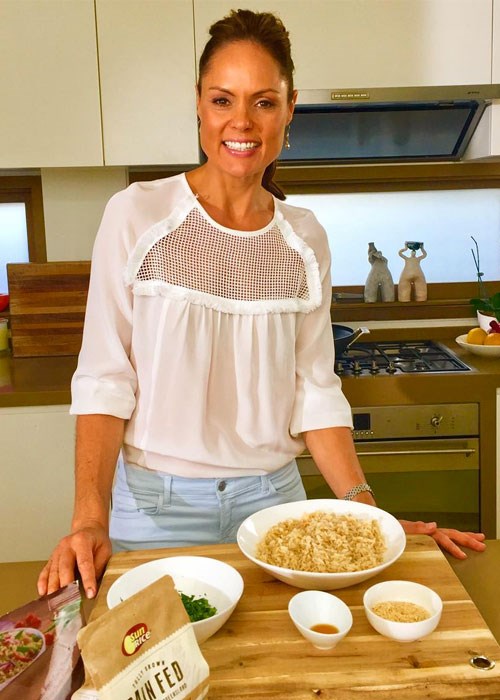A nutritionist weighs in with her advice
Love to share a selfie of yourself bare-faced or show off your favourite acai bowl on a Sunday morning? We get it. In an age where sharing on social media is completely normal, it was only a matter of time before something like #mealprep took over Instagram. We’ve spotted over five million posts about the food movement, which is all about preparing your weekly meals in one hit to ensure a balanced, well thought-out diet plan, with many of the snaps being of boxes and boxes of groceries loaded with seemingly healthy ingredients like rice, sweet potato, spinach, chicken, beans, etc. But what should you really be including in your weekly lunches and dinners? And more importantly, what foods keep their nutritional value the best over time? We picked the brains of nutritionist and author Zoe Bingley-Pullin for her best tips for meal prepping to your full potential.
#1 / Maintain a balanced diet
It goes without saying that a balanced diet is key to staying healthy and maintaining good mental health. “Aim to incorporate foods from each of the main food groups into meals, especially, complex carbohydrates, protein, and healthy fats,” says Bingley-Pullin.
“Complex carbohydrates include oats, sweet potato, rice, quinoa, buckwheat pasta, banana, wholegrain bread. Protein can be eggs, dairy, legumes and lentils, tofu, chicken, red meat, fish, raw nuts and seeds, whereas healthy fats are avocado, olive oil, tahini, raw nuts and seeds, and chia seeds.”
#2 / Pick the right proteins
Love the taste of pork, but hate how the texture becomes tougher as you reheat it? Then it may be worth considering a different kind of protein in your daily lunches. “The proteins that keep the best are boiled eggs with the shell kept on - they can be in the fridge for up to seven days [but] if they’re peeled, they have to be eaten that day,” explains Bingley-Pullin. “As for poached, baked or roasted chicken, legumes and lentils, and fatty fish like salmon, these can keep up to two days in the fridge.”
#3 / Add supercharged vegetables
No, not all vegetables are created equal, and you should keep this in mind when adding them to your meals. “Root vegetables like carrot, sweet potato and beetroot taste great when roasted and keep well in the fridge,” says Bingley-Pullin. “And vegetables with nightshades, such as eggplant, capsicum and tomatoes, can also be roasted or grilled and [placed] in olive oil in the fridge.” As for kale and spinach, “these are best kept unwashed in the fridge, and try to remove as much moisture as possible prior to storing.”
#4 / Think about reheating your vegetables separately
It may be convenient to have your vegetables mixed in with your proteins and carbohydrates, but you should store them separately to get the most out of all your ingredients. “Leafy greens are best added raw to meals, and raw vegetables should be added in at the last minute.”
As for your cooked vegetables, “these don’t necessarily need to be reheated, it’s a personal preference,” says Bingley-Pullin. “Exposing vegetables to heat can destroy water-soluble vitamins, especially vitamin C. However, griddle and microwave cooking has been shown to slightly increase or at least maintain the antioxidant content of vegetables. So if you are reheating, try to partially cook vegetables initially as the reheating can cook the vegetables more.”
#5 / Don’t forget about fibre
With so much focus placed on the right carbohydrate, protein and vegetable intake, it’s easy to forget about including a substantial amount of fibre in your diet as well to encourage healthy gut health. “Adequate fibre is crucial to digestive health and overall wellbeing, and is found in carbohydrate-containing foods such as grains, cereals, vegetables and legumes/lentils,” says Bingley-Pullin. “Nutrient rich herbs and spices such as turmeric, ginger, garlic, cumin, and coriander are an added bonus to boost the nutrient density of meals and a healthy way to flavour food.”
#6 / Watch out for portion size
Tempted to make yourself just a big bowl of roasted veggies for lunch or dinner? Keep these ratios in mind. “Aim for your meal to be ½ low-starch vegetables, ¼ plate protein, ¼ plate complex carbs and ½ -1 tablespoon of fat. If you’re extra active, the portion of carbs can be increased,” says Bingley-Pullin.
Obsessed with superfoods? Here are eight skin care products that contain lots of potent actives.
What are your favourite foods to use during meal prep, and why? Tell us in the comments below.
Main image credit: @zoebingleypullin

Iantha is BEAUTYcrew's Beauty Editor, and has been part of the team since the site launched in 2016. Besides pinky-nude nail polish and wispy false lashes, she has a healthy obsession with face masks and skin care ingredients. Her previous work can be found in Virgin Australia Voyeur, Women's Health, and SHOP Til You Drop.








